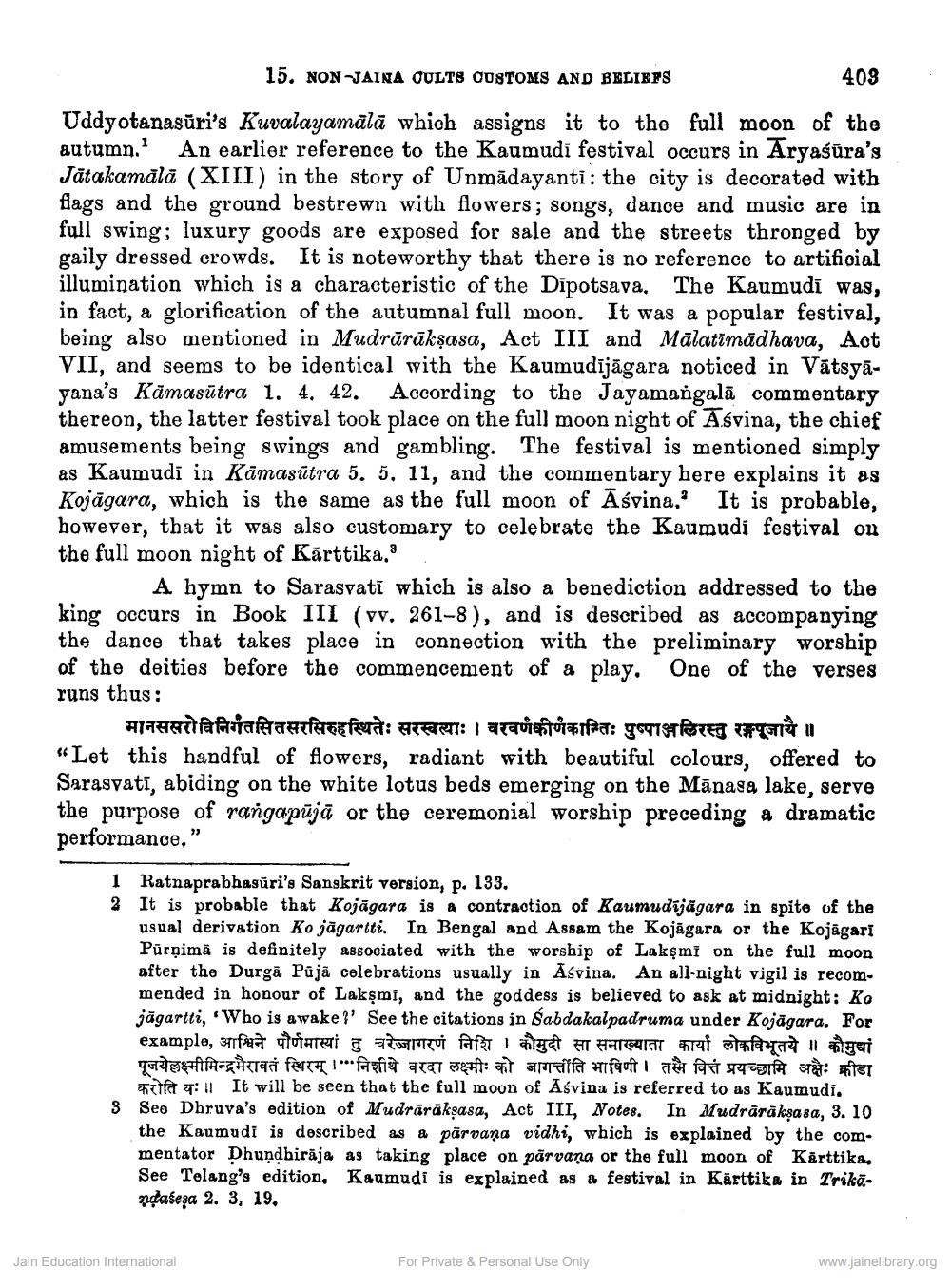________________
15. NON-JAINA OULTS CUSTOMS AND BELIEFS
403 Uddyotanasūri's Kuvalayamālā which assigns it to the full moon of the autumn. An earlier reference to the Kaumudi festival occurs in Aryaśūra's Jätakamālā (XIII) in the story of Unmādayanti: the city is decorated with flags and the ground bestrewn with flowers; songs, dance and mus full swing; luxury goods are exposed for sale and the streets thronged by gaily dressed crowds. It is noteworthy that there is no reference to artificial illumination which is a characteristic of the Dipotsava. The Kaumudi was, in fact, a glorification of the autumnal full moon. It was a popular festival, being also mentioned in Mudrārākşasa, Act III and Malatīmādhava, Aot VII, and seems to be identical with the Kaumudījāgara noticed in Vātsyayana's Kāmasütra 1. 4. 42. According to the Jayamangalā commentary thereon, the latter festival took place on the full moon night of Asvina, the chief amusements being swings and gambling. The festival is mentioned simply as Kaumudi in Kamasutra 5. 5. 11, and the cornmentary here explains it as Kojāgara, which is the same as the full moon of Asvina, It is probable, however, that it was also customary to celebrate the Kaumudi festival ou the full moon night of Kārttika.
A hymn to Sarasvati which is also a benediction addressed to the king occurs in Book III (vv. 261-8), and is described as accompanying the dance that takes place in connection with the preliminary worship of the deities before the commencement of a play. One of the verses runs thus:
मानससरोविनिर्गतसितसरसिरुहस्थितेः सरस्वत्याः । वरवर्णकीर्णकान्तिः पुष्पाञ्जलिरस्तु रगपूजायै ॥ “Let this handful of flowers, radiant with beautiful colours, offered to Sarasvati, abiding on the white lotus beds emerging on the Mānasa lake, serve the purpose of rangapūjā or the ceremonial worship preceding a dramatic performance,”
1 Ratnaprabhasūri's Sanskrit version, p. 133. 2 It is probable that Kojāgara is a contraction of Kaumudijāgara in spite of the
usual derivation ko jāgartti. In Bengal and Assam the Kojāgara or the Kojāgari Pūrņima is definitely associated with the worship of Lakşmi on the full moon after the Durga Pujā celebrations usually in Asvina. An all-night vigil is recommended in honour of Lakşmi, and the goddess is believed to ask at midnight: Ko jāgartti, 'Who is awake?' See the citations in Sabdakalpadruma under Kojāgara. For example, आश्विने पौर्णमास्यां तु चरेज्जागरणं निशि । कौमुदी सा समाख्याता कार्या लोकविभूतये ॥ कौमुद्यां पूजयेलक्ष्मीमिन्द्रमैरावतं स्थिरम् | "निशीथे वरदा लक्ष्मी को जागतीति भाषिणी । तसै वित्तं प्रयच्छामि अक्षैः क्रीडा mit 7: !It will be seen that the full moon of Asvina is referred to as Kaumudi. See Dhruva's edition of Mudrārāksasa, Act III, Notes. In Mudrārāksasa, 3. 10 the Kaumudi is described as a pārvana vidhi, which is explained by the commentator Dhundhiraja as taking place on pārvana or the full moon of Kärttika, See Telang's edition, Kaumudi is explained as a festival in Kärttika in Trikā. našeşa 2. 3, 19.
Jain Education International
For Private & Personal Use Only
www.jainelibrary.org




